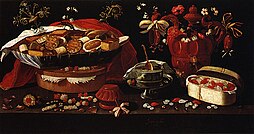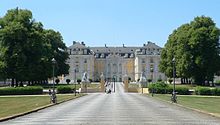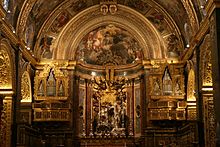Painting
A defining statement of what baroque signifies in painting is provided by the series of paintings (one of which is above) executed by Peter Paul Rubens for Marie de Medici at the Luxembourg Palace in Paris (now at the Louvre), in which a Catholic painter satisfied a Catholic patron: baroque-era conceptions of monarchy, iconography, handling of paint, and compositions as well as the depiction of space and movement.

Caravaggio, The Crowning with Thorns
Baroque style featured “exaggerated lighting, intense emotions, release from restraint, and even a kind of artistic sensationalism.” Baroque art did not really depict the life style of the people at that time; however, “closely tied to the Counter-Reformation, this style melodramatically reaffirmed the emotional depths of the Catholic faith and glorified both church and monarchy” of their power and influence.
There were highly diverse strands of Italian baroque painting, from Caravaggio to Cortona; both approaching emotive dynamism with different styles.
Another frequently cited work of baroque art is Bernini’s Saint Theresa in Ecstasy for the Cornaro chapel in Saint Maria della Vittoria, which brings together architecture, sculpture, and theater into one grand conceit.

Still-life, by Josefa de Óbidos, c. 1679,Santarém, Portugal, Municipal Library
The later baroque style gradually gave way to a more decorative Rococo.
A rather different art developed out of northern realist traditions in seventeenth-century Dutch Golden Age painting, which had very little religious art, and little history painting, instead playing a crucial part in developing secular genres such as still life, genre paintings of everyday scenes, and landscape painting. While the baroque nature of Rembrandt’s art is clear, the label is less often used for Vermeer and many other Dutch artists. Flemish baroque painting shared a part in this trend, while also continuing to produce the traditional categories.
In a similar way the French classical style of painting exemplified by Poussin is often classed as baroque, and does share many qualities of the Italian painting of the same period, although the poise and restraint derived from following classical ideas typically give it a very different overall mood.
Sculpture
In baroque sculpture, groups of figures assumed new importance and there was a dynamic movement and energy of human forms—they spiraled around an empty central vortex, or reached outwards into the surrounding space. For the first time, baroque sculpture often had multiple ideal viewing angles. The characteristic baroque sculpture added extra-sculptural elements, for example, concealed lighting, or water fountains. Aleijadinho in Brazil was also one of the great names of baroque sculpture, and his master work is the set of statues of the Santuário de Bom Jesus de Matosinhos in Congonhas. The soapstone sculptures of old testament prophets around the terrace are considered amongst his finest work.

Stanislas Kostka on his death bed by Pierre Le Gros the Younger
The architecture, sculpture and fountains of Bernini (1598–1680) give highly charged characteristics of baroque style. Bernini was undoubtedly the most important sculptor of the baroque period. He approached Michelangelo in his omnicompetence: Bernini sculpted, worked as an architect, painted, wrote plays, and staged spectacles. In the late 20th century Bernini was most valued for his sculpture, both for his virtuosity in carving marble and his ability to create figures that combine the physical and the spiritual. He was also a fine sculptor of bust portraits in high demand among the powerful.
Bernini’s Cornaro Chapel
A good example of Bernini’s baroque work is his St. Theresa in Ecstasy (1645–52), created for the Cornaro Chapel of the church of Santa Maria della Vittoria, Rome. Bernini designed the entire chapel, a subsidiary space along the side of the church, for the Cornaro family.

Bernini’s Ecstasy of St. Teresa
Saint Theresa, the focal point of the chapel, is a soft white marble statue surrounded by a polychromatic marble architectural framing. This structure conceals a window which lights the statue from above. Figure-groups of the Cornaro family sculpted in shallow relief inhabit opera boxes on the two side walls of the chapel. The setting places the viewer as a spectator in front of the statue with the Cornaro family leaning out of their box seats and craning forward to see the mystical ecstasy of the saint.
St. Theresa is highly idealized and in an imaginary setting. She was a popular saint of the Catholic Reformation. She wrote of her mystical experiences for an audience of the nuns of herCarmelite Order; these writings had become popular reading among lay people interested in spirituality. In her writings, she described the love of God as piercing her heart like a burning arrow. Bernini materializes this by placing St. Theresa on a butt while a Cupid figure holds a golden arrow made of metal and smiles down at her. The angelic figure is not preparing to plunge the arrow into her heart—rather, he has withdrawn it. St. Theresa’s face reflects not the anticipation of ecstasy, but her current fulfillment.
This work is widely considered a masterpiece of the baroque, although the mix of religious and erotic imagery (faithful to St Teresa’s own written account) may raise modern eyebrows. However, Bernini was a devout Catholic and was not attempting to satirize the experience of a chaste nun. Rather, he aimed to portray religious experience as an intensely physical one. Theresa described her bodily reaction to spiritual enlightenment in a language of ecstasy used by many mystics, and Bernini’s depiction is earnest.
The Cornaro family promotes itself discreetly in this chapel; they are represented visually, but are placed on the sides of the chapel, witnessing the event from balconies. As in an opera house, the Cornaro have a privileged position in respect to the viewer, in their private reserve, closer to the saint; the viewer, however, has a better view from the front. They attach their name to the chapel, but St. Theresa is the focus. It is a private chapel in the sense that no one could say mass on the altar beneath the statue (in the seventeenth century and probably through the nineteenth) without permission from the family, but the only thing that divides the viewer from the image is the altar rail. The spectacle functions both as a demonstration of mysticism and as a piece of family pride.
Architecture
In baroque architecture, new emphasis was placed on bold massing, colonnades, domes, light-and-shade (chiaroscuro), ‘painterly’ color effects, and the bold play of volume and void. In interiors, baroque movement around and through a void informed monumental staircases that had no parallel in previous architecture. The other baroque innovation in worldly interiors was the state apartment, a sequence of increasingly rich interiors that culminated in a presence chamber or throne room or a state bedroom. The sequence of monumental stairs followed by a state apartment was copied in smaller scale everywhere in aristocratic dwellings of any pretensions.
Baroque architecture was taken up with enthusiasm in central Germany (see, e.g., Ludwigsburg Palace and Zwinger, Dresden), Austria and Russia (see, e.g., Peterhof). In England the culmination of baroque architecture was embodied in work by Sir Christopher Wren, Sir John Vanbrugh and Nicholas Hawksmoor, from ca. 1660 to ca. 1725. Many examples of baroque architecture and town planning are found in other European towns, and in Latin America. Town planning of this period featured radiating avenues intersecting in squares, which took cues from baroque garden plans. In Sicily, baroque developed new shapes and themes as in Noto,Ragusa and Acireale “Basilica di San Sebastiano.”

Augustusburg Palace near Cologne

Trevi Fountain in Rome

Wilanów Palace in Warsaw

Interior of the Cornaro Chapel, Santa Maria della Vittoria church, Rome including the Cornaro portraits, but omitting the lower parts of the chapel.
Another example of baroque architecture is the Cathedral of Morelia, Michoacán in Mexico. Built in the seventeenth century by Vincenzo Barrochio, it is one of the many baroque cathedrals in Mexico. Baroque churches are also seen in the Philippines, which were built during the Spanish period.
Francis Ching described baroque architecture as “a style of architecture originating in Italy in the early seventeenth century and variously prevalent in Europe and the New World for a century and a half, characterized by free and sculptural use of the classical orders and ornament, dynamic opposition and interpenetration of spaces, and the dramatic combined effects of architecture, sculpture, painting, and the decorative arts.”
Theater

Eighteenth-century painting of the Royal Theatre of Turin
In theater, the elaborate conceits, multiplicity of plot turns and a variety of situations characteristic of Mannerism, in Shakespeare’s tragedies for instance, were superseded by opera, which drew together all the arts into a unified whole.
Theater evolved in the baroque era and became a multimedia experience, starting with the actual architectural space. In fact, much of the technology used in current Broadway or commercial plays was invented and developed during this era. The stage could change from a romantic garden to the interior of a palace in a matter of seconds. The entire space became a framed selected area that only allows the users to see a specific action, hiding all the machinery and technology – mostly ropes and pulleys.
This technology affected the content of the narrated or performed pieces, practicing at its best the Deus ex Machina solution. Gods were finally able to come down – literally – from the heavens and rescue the hero in the most extreme and dangerous, even absurd situations.
The term Theatrum Mundi – the world is a stage – was also created. The social and political realm in the real world is manipulated in exactly the same way the actor and the machines are presenting/limiting what is being presented on stage, hiding selectively all the machinery that makes the actions happen.
The films Vatel and Farinelli give a good idea of the style of productions of the baroque period. The American musician William Christie and Les Arts Florissants have performed extensive research on all the French baroque opera, performing pieces from Charpentier and Lully, among others that are extremely faithful to the original seventeenth-century creations.

